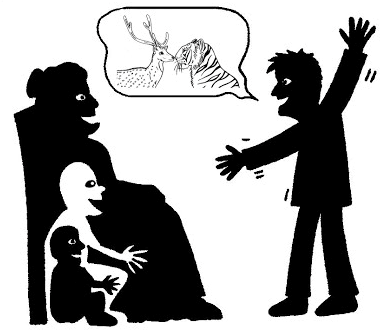A common legend suggests that a form of art is great presentations. While certain artists are some of the world's best performers, we know their performances follow the kind of narrative structure that allows even novice lecturers to offer great lectures.
So, what is a structuring of narrative?
Well, it is the industry, because in every profession, the narrative structure is important. Although there are different definitions, they all point to the "structural framework" for presenting an idea or history to an audience. The reliance on the structure of a story reveals how powerful, engaging presentations can be accomplished. Since if we can show how they are constructed (e.g. the skeleton), the rest is to add muscle or content and deliver according to the narrative structure. The idea or story is the other key element in the definition of the narrative structure. There is no plot to create without the premise or tale. Thus, as a way to engage our audience, we really want to rely on storytelling.

Importance of structuring of narrative
At least one story must be told by all of us. Businessmen often have a lot. Financing, financing and customer acceptability of a product or service are not just problems they tackle, it is the tale behind the problem and the way they can be solved.
Presenting this story in a context that is right allows future investors and consumers to get involved. Submissions are no exception. Gary Vaynerchuk is an internationally renowned serial entrepreneur and four-time New York Times selling author who gives amazing presentations every time he opens his mouth. Vaynerchuk points out the value in his novel, Jab, Jab, Jab, Right Hook: How to Tell Your Story in the Noisy Social World, of having the idea's thrust (the right hook). This "build-up," Vaynerchuk called the jab, jab, and jab, in the film industry, is known as the plot. The screenwriter delivers a plot through a 3-act structure, which is slowly generated (jabs) to the climax of a film (right hook).
Real-life scenario of narrative
Let's look at how in business the narrative structure works. Both stages may be defined differently by various sectors or experts. But, without a question, the first act, the problem, or what Simon Sinek calls the "why" always start great presentations.
First rule/ the 'why’
Whether it’s a script production, pitch deck or other presentation, a problem often starts with a narrative. It gets them involved early by presenting this problem to an audience. Someone can be lost and must be saved in a movie. A growing issue that we saw in hit movies such as Finding Nemo and San Andreas. In the business sector, this problem is ultimately the object behind the company. Three of the four successful presentations started to list a problem in black and white in the famous pitch-decks listed here, including those used by Airbnb, Intercom, Buffer and Slidebean. Now, these companies solve these issues.
The second rule
Throughout the Second Rule, the story goes on to the next level, as the audience understands and identifies the issue. The second rule is named in a movie by screenwriters. According to the examples above, Nemo is alone in a new world as a small fish; the rock rekindles his friendship with his ex-father. The Second Rule contains a clear presentation that explains how the problem found in the first act is solved and how it works. It is what Vaynerchuk calls "jabs," and presenters can quickly develop their confidence and their relations by encouraging the public to rally behind them by revealing the solution, piece by piece, through drip-feeding exciting features with lots of application potentials.

Tips for Slides in Second Rule:
Most presentations include visual and vocal elements. Visually, use of point-form icons increases interaction. Statistics, quotes and figures are vocal and involve publics, but make sure you use the right ones! For example: 100% of the presenters used figures in their presentations in each of the pitch decks of our web. 75% used icons of minimal text extensively. (Look at what we did?)
The group was drawn to this stage in the story. It is the same goal for everyone: to solve the question found in the first act. The second act also gives the crowd the best way to achieve their goal behind the solution presented, and they trust that the solution's team or company will deliver this objective. In the examples of our film, Nemo pulled together the other fish in the tank to help him get out and come back; that's in San Andreas where the Rock won over its ex-wife successfully. In an enterprising world, Airbnb has shown how everybody gains through their social and service network by making or saving money and how Intercom and Slidebean have shown that their solutions do this not only solve a problem but are often quickly and efficiently used.
The third rule
In a film the missing child gets together in a family — Nemo gets together with his father; the rock sees and rescues his daughter from a falling building after a near-drowning. With the audience behind the solution, Vaynerchuk calls the Third Rule the right handshake. In the business world, the Third Rule works the same. It is where the viewer gets what they want or lack: not only a solution to the common problem found under the first Act but also a solution to a broader version of the problem! Remember that it's not about calling for the company to deliver this important right hook, anyway not yet. Unlike the "jabs," the narrative structure indicates the presenter is reiterating the issue and adding an element of surprise or twist that could not be taken into account by the public. Thus a cloud operation can solve not only file access problems in the second act, but also the third act problem, where access to files is forbidden by a complete server hack, which locks all file access 15 minutes before an important investor's meeting, that determines the company's fate.
The right hook is followed by a strategy which the team or organization has already shown that it can overcome competently in the business presentation. A right hook in the third act is appropriately presented, leaving the viewer with no choice but to act upon your call to action. The Airbnb pitch deck shows just how much cash can be paid and what gives the Airbnb solution a competitive advantage. Since the public's desire to narrate lies more in the structure's familiarity than in the story or idea itself, the audience is invited to present great lectures which conform to the rules of the narrative structure.
It's not the narrative or any other creative aspect that attracts an audience. The truth behind big presentations. Rather, it's the narrative structure's familiarity. If the audience sits in a Hollywood film studio or a Wall Street boardroom, the structure is a three act science that all great storytellers, even the greatest Shakespeare artists in history, will know, and create. The structure is a three act science.

